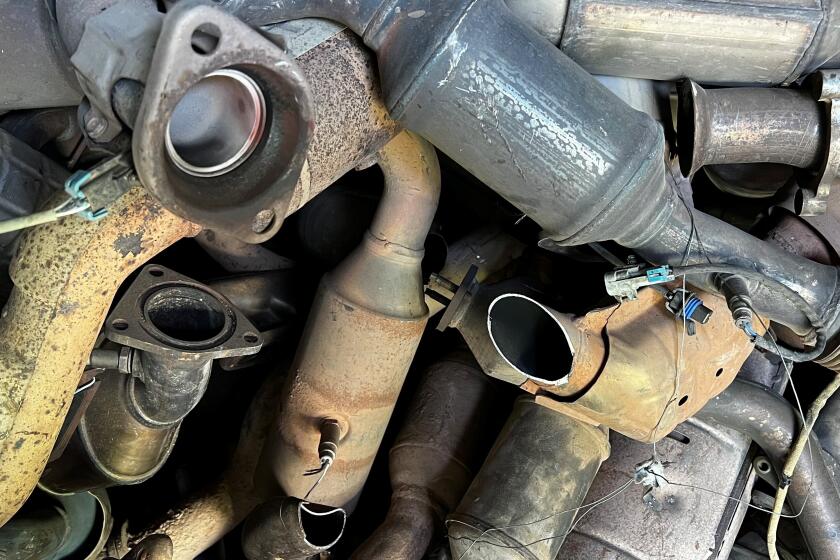Take Knife to Recreation Budget and Repent at Leisure
- Share via
On July 1 there was a changing of the guard. We stand on the threshold of what could be a new era in Los Angeles as Mayor Richard Riordan assumes leadership.
The real future of our city, however, rests with its youth, and little attention has been directed toward their needs.
Riordan campaigned on a “more police, get tough on crime” platform. The 1994 city budget reduces funding for after-school recreation and parks programs. At the state level, officials predict devastated youth services and the closing of 24 county parks.
Once again we see our city taking a step backward, for recreation services are a cost-effective way to bring communities and families together.
Let’s look at some facts.
First, get-tough policies don’t work.
California leads the nation in prison population--562,000 in 1992, 2% of Californians over the age of 18. Yet as the prison population has doubled and redoubled, the crime rate has dropped little.
Violence involving youth is spreading into L. A.’s suburban, middle-class valleys. More and more working parents are leaving their children unattended after school.
We cannot incarcerate an entire generation. Prevention and rehabilitation have to be the answers of the ‘90s.
The Carnegie Commission’s report “A Matter of Time,” issued in 1992, noted that nearly half of America’s youth have too little to do after school and are in danger of falling victim to drugs, gangs, sexual activity and other negative pastimes. The report indicted schools, churches, recreation centers and other community agencies as having failed to provide safe and engaging places to spend free time.
But there are some success stories.
One we are familiar with is at Cal State Northridge, called Parks and Recreation: Outreach to Urban Departments--PROUD. Developed by the Department of Leisure Studies and Recreation, it organizes students and faculty to offer their time and service to communities to enhance leisure opportunities.
A demonstration project at Lanark Park in the west San Fernando Valley brings together business people, community volunteers, college students (through PROUD) the Police Department’s Project Amigo, Los Angeles Recreation and Parks Department staff and local youth to organize co-ed sports programs.
Former City Councilwoman Joy Picus’ Keeping Youth Doing Something program provided the umbrella for the cooperative venture, which was partly funded by a federal grant.
Here are some others:
* L. A.’s BEST incorporates high-self-esteem activities into after-school programs in the Los Angeles school district to make elementary school children associate positive outcomes with school. Nutrition, tutoring and recreational activities are combined to keep kids busy and involved with adults who care, many having come from similar backgrounds to the participants.
* Early intervention is often critical in keeping kids from drugs and violent lifestyles. Echo Park Recreation Center offers child care and related family assistance.
* The Jordan Downs Recreation Center shows what a housing project community center can do when parents and recreation staff work together to save the children.
* The San Diego school district has New Beginnings, which brings together social-services agencies, family advocates, professors from a local community college, health-care professionals and school personnel to assist families in dealing with myriad problems.
These successes have common elements.
First, they approach people in a non-threatening environment. Recreation centers can be established as “neutral” turf when viewed as critical to the survival of their communities. Community Youth Gang Services’ late-night basketball programs exemplify this type of success.
Second, they deal with the whole person, not just one aspect of the individual’s life. Community centers often provide space for a variety of community activities, including language classes, child care, self-help workshops, as well as recreation programs for a variety of age groups. There is an appropriate place for fun in everyone’s life.
Finally, the recreation center represents success and acceptance for people who may feel alienated and abused by their experiences with other human-service agencies. Self-esteem and self-worth are enhanced by non-critical assistance in stabilizing one’s life, gaining information and skills.
The programs described above did not cost a lot of money. They required a new way of thinking about how to provide services at the community level.
Recreational activities have been incorporated into successful approaches to youth-offender rehabilitation utilizing an austere camp-like atmosphere offering structure and discipline. Adventure recreational activities expose teens to risk and team-building to solve problems.
In “Los Angeles: Capital of the Third World,” David Rief writes: “We must love one another or die.”
These words carry serious meaning in light of gang violence, drive-by shootings and riots which extend beyond inner-city Los Angeles to tourist spots like Venice Beach and Magic Mountain. Let’s not overlook the rich resource to be cultivated by reclaiming our parks and recreation facilities as focal points for community action and service. Let’s “rebuild L. A. the recreation way.”
More to Read
Sign up for Essential California
The most important California stories and recommendations in your inbox every morning.
You may occasionally receive promotional content from the Los Angeles Times.










